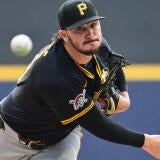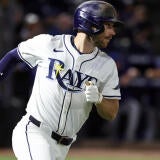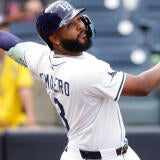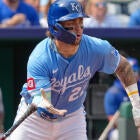Why Carlos Gonzalez's turnaround isn't all good news
Fantasy players who were patient and waited for Carlos Gonzalez after his slow start could have their patience punished at the trade deadline, Chris Towers says at the Fantasy Baseball Today blog.
On May 13, Carlos Gonzalez struck out twice in a loss to the Angels, the second game in a row he had recorded multiple strikeouts. Despite ending a four-game hitless streak with a single, the 1-for-5 game also left him at rock bottom for the season, as his triple-slash line fell all the way to .188/.245/.297.
That .542 OPS wasn't exactly a season-low -- he hit .511 in mid-April -- but it certainly represented the worst point of his season, all things considered. Gonzalez hadn't homered in 20 days, and hadn't had multiple hits in a game in three weeks exactly. For the 29-year-old coming off years of injuries, it certainly looked like his best days were behind him.
To say Gonzalez has turned things around since would be a massive understatement. Capped off by a 3-for-4 showing with two homers Sunday, Gonzalez is not hitting .308/.362/.588 since May 14, a span of 60 games. That is pretty much peak Carlos Gonzalez, a player I had pretty much written off ever seeing again. What is fueling his sudden return to form, and can he keep it up?
With Gonzalez, the biggest thing in the last few years has been his health, but that hasn't been an issue this season. He missed one game in late May with an illness, and then one more in late June with a left hand injury, but has otherwise been in the lineup pretty consistently. He did have a scare in March with his surgically repaired left knee, and it is possible the recovery from the surgery bled into the season and contributed to his slow start.
Gonzalez hasn't been running much this season, but it may not be coincidental that his first stolen base attempt of the season came one day after his turnaround began. Maybe it isn't such an arbitrary endpoint? If his body is finally healthy, this turnaround might be a lot more than just a random hot streak -- especially since most hot streaks don't last 70-plus days. Are there other indicators that his turnaround might be sustainable?
Since May 14, Gonzalez has an average exit velocity of 90.7 miles per hour, and an average batted-ball distance of 319.4 feet, per BaseballSavant.com. That batted ball distance is up from 303.6 feet, before that date, however his exit velocity has actually fallen from 92.5 miles per hour, so it isn't all good news. He also hasn't significantly improved his swinging strike rate much, another sign that he isn't a significantly different hitter right now.
And, in nearly half of his games, he really doesn't look all that improved. As has been the case throughout his career, Gonzalez has been significantly better at home than on the road. In 26 games away from Coors Field since May 14, he is hitting .250/.292/.470; for a career .255/.307/.431 hitter away from Coors, that isn't particularly surprising.
So, CarGo is back. Since May 14, he's basically been the same player as always, and that is very good news for those of you who bought low on him or held on through the bad times. Of course, the player Gonzalez has always been throughout his career might make him an excellent sell-high candidate, since he just might be leaving Coors Field this week for good.
The paradox of Gonzalez's return to form is that it makes him a much more attractive trade candidate for the Rockies ahead of Friday's deadline, as team blog PurpleRow.com noted earlier today. That would be an absolute worst-case scenario for Gonzalez, who hits like a star in Colorado but hits like Preston Tucker on the road.
If you own Gonzalez, you're in a tough place. If he stays in Colorado, he's probably a top-20 outfielder for the rest of the season based on his last two months. On the other hand, he might not even be a top-50 outfielder if he is moved. The risk here is huge, and it might make moving him in a trade your best option; even if you don't get the same value back, avoiding that downside might make it worth it.
Owning Gonzalez the last two years has been extremely frustrating, so it is only natural that his return to form carries plenty of frustration with it as well. It's never easy with him at this point.
















